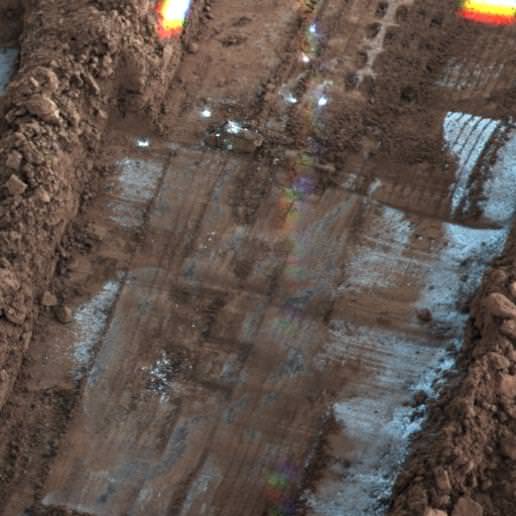[/caption]
Scientists from the Phoenix Mars Lander mission say the lander uncovered clues that the Martian arctic soil has been warmer and wetter in the past, and right now Mars may just be in a dry cycle. The biggest clue is the “clumpiness” of the soil in the Mars arctic region that Phoenix encountered, making it difficult for the lander to dump samples into the “ovens” that analyzed the chemistry of the soil. While currently the soil is cold and dry, when long-term climate cycles make the site warmer, the soil may get moist enough to modify the chemistry, producing effects that persist through the colder times. “We have snowfall from the clouds and frost at the surface, with ice just a few inches below, and dry soil in between,” said Phoenix Principal Investigator Peter Smith of the University of Arizona , Tucson . “During a warmer climate several million years ago, the ice would have been deeper, but frost on the surface could have melted and wet the soil.”
With no large moon like Earth’s to stabilize it, Mars goes through known periodic cycles when its tilt becomes much greater than Earth’s. During those high-tilt periods, the sun rises higher in the sky above the Martian poles than it does now, and the arctic plain where Phoenix worked experiences warmer summers.
“The ice under the soil around Phoenix is not a sealed-off deposit left from some ancient ocean,” said Ray Arvidson of Washington University in St. Louis , lead scientist for the lander’s robotic arm. “It is in equilibrium with the environment, and the environment changes with the obliquity cycles on scales from hundreds of thousands of years to a few million years. There have probably been dozens of times in the past 10 million years when thin films of water were active in the soil, and probably there will be dozens more times in the next 10 million years.”
Cloddy texture of soil scooped up by Phoenix is one clue to effects of water. The mission’s microscopic examination of the soil shows individual particles characteristic of windblown dust and sand, but clods of the soil hold together more cohesively than expected for unaltered dust and sand. Arvidson said, “It’s not strongly cemented. It would break up in your hand, but the cloddiness tells us that something is taking the windblown material and mildly cementing it.”
That cementing effect could result from water molecules adhering to the surfaces of soil particles. Or it could be from water mobilizing and redepositing salts that Phoenix identified in the soil, such as magnesium perchlorate and calcium carbonate.
The Thermal and Electrical Conductivity Probe on Phoenix detected electrical-property changes consistent with accumulation of water molecules on surfaces of soil grains during daily cycles of water vapor moving through the soil, reported Aaron Zent of NASA Ames Research Center, Moffett Field, Calif., lead scientist for that probe.
“There’s exchange between the atmosphere and the subsurface ice,” Zent said. “A film of water molecules accumulates on the surfaces of mineral particles. It’s not enough right now to transform the chemistry, but the measurements are providing verification that these molecular films are occurring when you would expect them to, and this gives us more confidence in predicting the way they would behave in other parts of the obliquity cycles.”
Phoenix worked on Mars this year from May 25 until November 2.The Phoenix science team will be analyzing data and running comparison experiments for months to come. Today, they reported on some of their progress at a meeting of the American Geophysical Union in San Francisco.
Source: NASA


Wow, is that just a prismatic effect of the light refracting and reflecting off the ground ice. or…. is it precious opals i see there!? Maybe well get to mars sooner if they can scrape up some shiny gems lol.
Here on earth they take core samples to judge the conditions of weather. How can just a few inches of scraping of the soil give such a significant answer?
Because we haven’t dug down into the Martian arctic soil before?